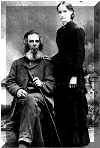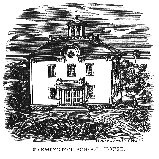
Contents:
A House History Hunting GuideOther Issues:
More than 400 County residents participated in the Dakota County Homestead Family Reception at the Western Service Center in Apple Valley on March 3.
The DCHS, who organized the event, asked the F AHS to research and submit the names of the families living in Castle Rock, Empire, and Eureka Townships during the territorial period from 1849 to 1858.
Using government documents from the period the FAHS compiled a list of family names for the DCHS and assisted in locating descendants.
The largest clan gathered at the event was the descendants of the Hoffman family from Hampton with 49 family members. The Krech family from Inver Grove had 43 and the Quigley family from Eagan had 29 family representatives.
The Stapf family from Castle Rock had 14 members present as well as the Van Slyke from Eureka.
The Scofield and Torrison families from Eureka both sent 11 family representatives.
Reverend Gary Cavender, a member of the Mdewakanton community, shared with the group what Native American life was like before the territory was open for settlement.
Hy Berman, Professor of History at the University of Minnesota, spoke about the territory before statehood in 1858.
Austa Harmer and Wendy Kooda represented the Farmington Area Historical Society.
FAHS Participates in Planning County’s 150th
The Farmington Area Historical Society has been asked to share its time and talents in helping Dakota County plan its Sesquicentennial Celebration this year.
Dakota County was officially organized by the first territorial legislature on October 27, 1849.
One of the projects FAHS members have recently worked on with the County and the Dakota County Historical Society (DCHS) is the location of historic sites in the Castle Rock, Empire, Eureka and Farmington areas for the new 1999 county highway map.
The points of interest located and submitted by the FAHS included geographic sites, such as lakes and river given in their Native American names, and territorial settlement sites such as Poplar Grove in Castle Rock Township and Farmington in Empire Township.
Alidon Amidon’s hotel and stagecoach stop north of the Vermillion River on today’s Highway 3 were also included. This was the first stop on the St. Paul to Fairbault Road, as it was called then. Farmington was one day’s travel from St. Paul before the coming of the railroad.
Former sites of the County Poor Farms, fairgrounds, cemeteries, historic buildings and the Nike Missile Base were just some of the sites suggested to be used on the map. The sites must be accessible by car.
The FAHS submitted 17 historic sites of which the DCHS selected four. Pen and ink sketches representing the Exchange Bank Building and the former Dakota County Tribune building in Farmington, the former Horticultural building and a Nike missile silo in Castle Rock Township make up a part of the map. The map also includes a brief history of the County government.
County Projects
The County’s Sesquicentennial Celebration was a part of the agenda of an earlier FAHS meeting last October. The FAHS chose to develop three sesquicentennial projects for the County. The first, a sesquicentennial heritage apple orchard for the County fairgrounds, has already been presented.
The second project, a Dakota County Soldiers Monument, is still being researched. The monument will include all the
names of the men from the County who fought and died in our nation’s wars.
And the research for the third, a territorial signage project, has already been submitted to the County. The communities that were here before statehood will receive a sign recognizing that fact.
FAHS Projects
Members also discussed walking and biking tours of Farmington, and bus tours of the surrounding townships. Research is continuing in developing a "Peony Day Celebration" in June. The one-day event focus on Farmington’s past community celebrations.
Work has also begun on a fourth grade level history program for the elementary schools. A video, slides and stories will help to tell the County’s and Castle Rock, Empire, Eureka and Farmington’s history. The program will be ready and available to students later in the year.
So, Where Are These Dakota County Territorial Communities?
According to the Dakota Weekly Journal, a territorial newspaper published in Hastings, there were nine communities already in existence by 1856. Some of the names of the communities have changed while other communities are no longer among us. Athens, for example, is now known as Inver Grove Heights. Rose Mount became a one-word town. Poplar Grove in Castle Rock Township went missing and the little metropolis of Lewiston was swept off the face of the earth after a deluge.
The nine territorial communities described in the June 21, 1856 issue of the Dakota Weekly Journal are Athens (Inver Grove Heights), Farmington, Hastings, Lakeville, Lewiston, Mendota, Poplar Grove, Rosemount and Waterford. These were Dakota County’s firstborn communities.
Adapted from Alan Lathrop and Barbara Bezat, Drafting a House History, Northwest Architectural Archives, University of Minnesota, © 1979
Building Permits: Building permits are documents that grant permission to construct or remodel a building or, sometimes, to demolish one. They should contain the original owner’s name, the approximate date of construction, and the name of the architect or builder. Permits are issued by building inspection departments and are retained in those offices. Building permit indexes, listing all permits for each structure, are usually kept at the inspector’s office. Check for building permits at city hall or county offices.
Abstract of Title: The abstract is a summary of all legal actions pertaining to the property. It is most useful for tracing owners of the property and for construction a history of the land parcel on which the house is situated. Abstracts are held by the titleholder – either the homeowner or the bank.
Plat maps: These are maps made by developers at the time a piece of land was being developed into a neighborhood. Check the Dakota County’s Recorder's office, the City of Farmington, the Township halls, and the Dakota County Historical Society’s collection.
Atlases: These are large collections of maps detailing streets and structures made by commercial companies, often for insurance purposes. The Minnesota Historical (Minnesota History Center in St. Paul) has the Sanborn Insurance, the Hopkins Company, Foote and Rascher atlases. The Farm Bureau publishes a county atlas, which is useful for tracing land ownership. Look for atlases at the Farmington Library and the Dakota County Historical Society.
Photographs: The Dakota County Historical Society has a large collection of photographs and old postcards. The Audio-Visual Collection at the Minnesota History Center in St. Paul is another possibility.
Your neighbors: Longtime residents are an excellent source of information about who lived where.

The Minnesota Central Railroad donated two lots, numbers 10 and 11, in block 26 as the site of the new school in the spring of 1869.
The school board made the decision to have the school building constructed in the middle of the two lots, allowing a large space for the children to play and future expansion of the building.
Farmington’s residents watched with anticipation the construction of the school. The foundation was excavated by hand and like many of the building in town, limestone was used for the foundation walls.
The schools heating and ventilation system was the most modern of its time. No more cold classrooms and shivering children. No more hauling of wood to fuel the stove.
Skilled masons, bricklayers, carpenters and plasterers had the two-story four-room blond-brick building completed and ready for the new school year in September.
A minor accident marred what was otherwise an uneventful construction period. Three boys on a sunny Saturday afternoon, while the construction workers were not laboring, entered the nearly completed building. A rope going up to the roof and bell tower was dangling and waiting to be pulled. A tug on the rope sent bricks from the roof falling down on the boys. A deep gash in one of the boy’s cheek was his souvenir of the visit.
William Cope welcomed his student’s back on the first day of class. He would only teach for one year. The riff between Cope and the school board never was resolved. The school board, Dr. Levi Dodge, Leroy Fluke, and Knight Record began the search for Cope’s replacement.
The Donaldson School, No. 44, in Eureka Township, attracted many area students due to its instructor, Fredus C. Carpenter.
Born in Eastford, Connecticut in 1820, Carpenter attended school there and later graduated from a neighboring teacher’s academy. He taught school in Connecticut for several years.
The lure of gold discovered in California in 1849 led the 29-year-old teacher west. He returned home to Connecticut three years later "carrying his treasure gathered in the mines in a buckskin belt, worn under his clothing, next to his body."
Carpenter became occupied in the manufacturing and mercantile business until his health failed. He was told by his physicians to take up an "outdoor occupation." Not wanting to return to the rocks of a Connecticut farm, he moved to Minnesota in 1855 and purchased a farm in Lebanon Township (present day Apple Valley) where his wife and four sons joined him.
Carpenter taught school during the winter months in Lebanon, Nininger, Lakeville, and Vermillion. He moved to Eureka Township in 1867 and taught at the "Curry District" for several winters. He was an exceptional teacher and Farmington had its eye on him.
Carpenter replaced Cope in 1870 and served as the school’s principal. The new school was known as "Mr. Carpenter’s School" in the Farmington Press and the students as "Mr. Carpenter’s Boys."
Carpenter taught the Grammar school, Miss Foster was responsible for the Intermediate classes, and Miss Hattie Woodhull taught the Primary classes. Fifty-four students comprised the student body of 1870.